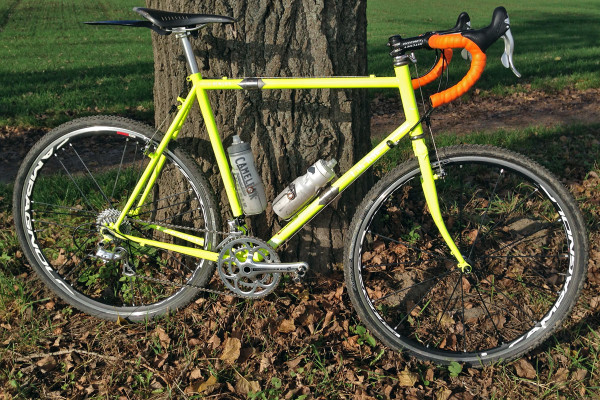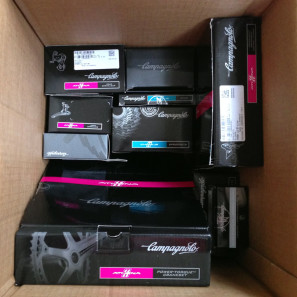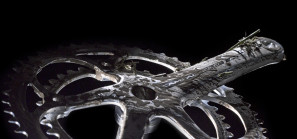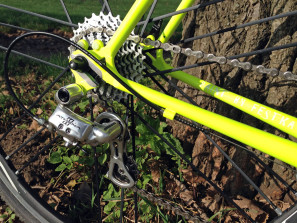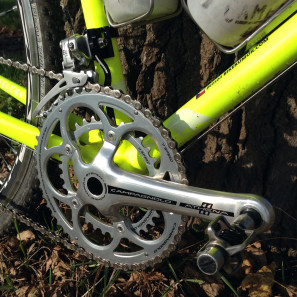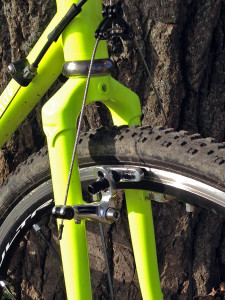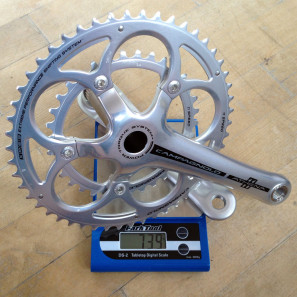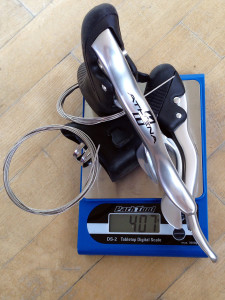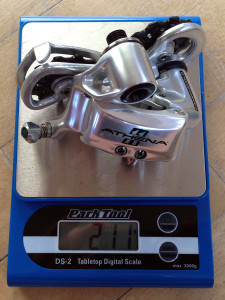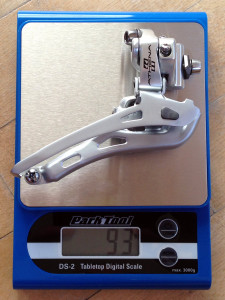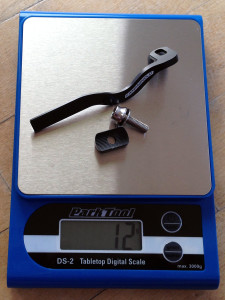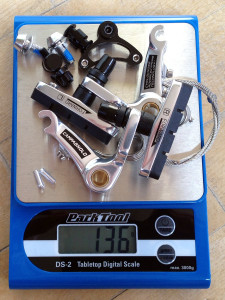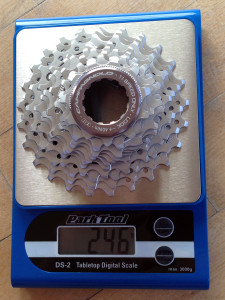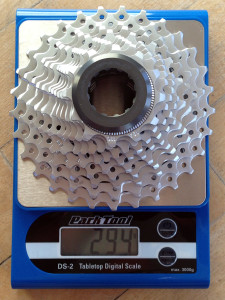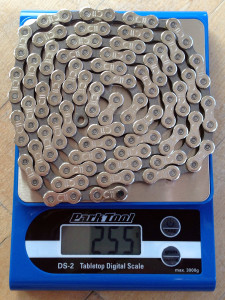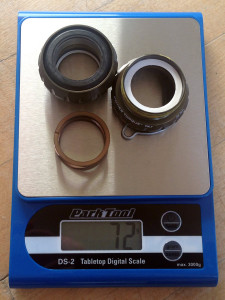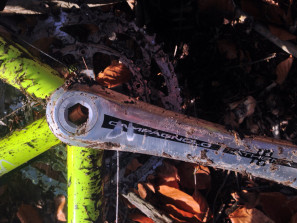Starting mid-cyclocross season last year we wanted to take a look at a more affordable groupset up to the task of surviving everything from road riding and winter training, through to the full stresses of cyclocross racing. We reached out to Campagnolo as we’ve long been a fan of their classic design and the ergonomics of the most recent generation of their 11 speed Ergopower levers, but don’t see them as much spec’ed on the bikes we test. While Campy has yet to offer a disc brake solution (we’ve been hearing a recent uptick in unsubstantiated rumors that we might see something soon), we still use an S&S coupled steel bike for some product testing and thought it’d deserve a fresh build. Plus, there are plenty of cyclocross bikes left that use cantilever brakes, and the test bike could serve us well for mixed road and trail touring too.
The silver Athena is a bit of a holdout, as the best gruppo Campagnolo makes that eschews carbon for an all polished aluminum finish. It uses a lot of trickle down tech from the top-tier groups, while maintaining a classic aesthetic. We thought that would nicely compliment this TIG-welded steel bike with a lugged fork, so we set out for a rebuild project. Join us after the break for the details of the build, actual weights of the components, and our first impressions when we put Athena to the test on the dirt and in the mud…
Even though we see all kinds of new tech and a lot of products showing up to test, it is still pretty exciting to have a box like this show up at our door. Different than having someone lend us a complete bike for a month or two to test, when a complete Italian gruppo shows up, it means fun times of getting to liven up an old bike with a complete overhaul. While Campagnolo isn’t as big of an OEM supplier for cross these days, it’s nice to see from their website that they give a dedicated cyclocross option for most of their groupsets and aren’t afraid to show some pictures of dirty parts.
The Athena 11 group is fourth in line with Campagnolo’s mechanical groupsets and has its own levers, derailleur, and crankset. It shares cassettes and a chain with the next up Chorus group. The cantilever CX brakes are non-series, so get shared throughout all of the groups. And the bottom brackets are shared by axle and bearing type, so here Athena and Veloce share PowerTorque.
Campagnolo offers its rear derailleurs in one length for 2×11 drivetrains, and this short (55mm) cage Athena 11 rear mech is rated to a max of a 29 tooth cog. Since it’s been years of using only Campy cassettes with Campy derailleurs, they’ve limited the options of what gearing choices you can use. However, since 11 speed has mostly gotten rid of the cassette spacing difference from one company to the next, it’s become more realistic to use other cassettes with a Campagnolo group. We’ve used a SRAM wheel with an 11-30 without any problems on this bike, although it is noisy in the low:high (36:11) gear. But most of the time we’ve spent between an 11/25 and 12/29 on two Campagnolo wheelsets, and were never unhappy with the gearing options for our type of riding.
As the highest group to not switch to the newer 4-bolt cranksets, our Athena group gets a standard forged aluminum crank with Campagnolo’s almost-110 BCD. Unfortunately Campagnolo still thinks it is OK to use their proprietary bolt circle diameter (the hidden bolt behind the crank arm is on a 112.5mm diameter, necessitating Campy-specific rings), so we get limited compatibility here and had to search to do a bit of experimenting with alternate chainrings. It really is a shame, because this otherwise nice looking crankset would be a much better choice it had a proper 110 BCD. The compact-specific CT braze-on front derailleur gets an updated all-steel cage design for better shifting, and a new integrated Chain Security Device (CSD), that while not cyclocross specific, has so far kept us from any dropped chains whether racing cross or trail riding. Campy’s cantilever CX brakes are a simple, wide style brake with plenty of leverage. While they don’t show up clearly on Campagnolo’s website, they are readily available from suppliers. The brakes have long arms with a high mechanical advantage, so we set ours up with a very high straddle cable for lots of modulation. Used on aluminum rims with the Campy levers that pull a lot of cable, this resulted in good power and excellent modulation that kept our hands from getting tired on long technical descents (especially on mountain bike trails and long gravel mountain roads.)
For those looking for a more modern look, the Athena groupset is also offered in a stealth all-black finish. A 5-bolt carbon crankset is another option. Athena also offers a triple setup with special front and rear derailleurs, a specific left lever, and triple 30/39/52 crankset, all intended for loaded touring and mountain riding. Since we were building up a cross bike we stuck with the double to start and went with cantis, but a non-series set of Skeleton caliper brakes are also available for road builds.
Breaking down the group we built up, at the heart we have a 110 BCD Athena Power-Torque CT Crankset with 172.5mm arms. You can see that even with a shorter length to the pedal threads, the overall crank arm length is the same for all available lengths. There’s certainly room in this one-forging-fits-all for Campagnolo to drill the cranks for a longer arm, so don’t expect a weight savings with shorter cranks. Including its 50/34 chainrings it weighs 739g and retails for 170€/$305. The Power-Shift 11s Ergopower Control levers retail for 150€/$265 and weighed 407g, including the two shift wires that were pre-installed. The 105€/$190 11s short-cage rear derailleur weighed 211g, putting this core of the group within about 1% of the claimed weights. Not bad.
Our Athena CT braze-on double front derailleur weighed in at 93g and retails for just 40€/$65, while its braze-on mount chain device adds 12g including its replacement bolt. It unfortunately is the same price across all groups and retails for about 35€/$45 making it relatively pricey. One complete cantilever CX brake setup weighed 136g, including the brake arms, pads, straddle wire, and all necessary mounting hardware. Weight is for one pair of brake arms (front or rear) so double the weight for a complete bike set which will sell for about 100€/$175.
The Chorus cassettes that we tried were a 246g 11-25 & a 294g 12-29. Both retail for the same 135€/$225. The Chorus chain comes in at 255g uncut with 114 links and sells for 40€/$70, inluding one single use assembly pin. The external BB weighs 72g and costs 20€/$40.
As you can see, and may or may not know, pricing from Campagnolo is a bit all over the place. From what we gather Campagnolo gives suggested retail pricing to their retailers and allows them a decent amount of leeway to price them above or below that, and sells it to different distributors and end-of-the-line retailers at different prices. What that means is some shops might not be able to profitably sell at these suggested prices, while others will sell below it, so keep that in mind. It is also a good bit more expensive outside of Europe. The setup we have on this bike pieced together individually (with just 1 cassette) could retail for under 900€ in Europe and over $1500 in the US. With exchange rates as they are that it is a pretty major difference and will definitely help make the decision to buy Campagnolo or not.
First Thoughts
So what about our time installing and riding it? Well, the traditional build went together super quickly and was easy to adjust and get riding. The only annoying thing is the use of a 14mm hex to install the crankset. Nobody normal has that in their tool box, so even we had to stop by our friendly neighborhood bike shop to put the cranks on. The new silver groupset definitely made our old bike look good, and adding in the set of Campagnolo Shamal Ultra tubulars that we reviewed last October helped shed some weight off vs. its last pieced together build.
Out riding the drivetrain did its job very well. The ergonomics of the levers is very nice and pairs well with the brakes for excellent modulation. The shape of the hoods with their little ribs does a good job of conforming to our hands comfortably without gloves and feeling grippy with gloves. Shifting is precise and offers positive feedback. For those who like riding on or just behind the hoods, Campy’s thumb button makes downshifts easy. Unfortunately, the Athena thumb paddles only offer one shift at a time (unlike the higher end control levers), but the upshift paddle still gives you up to three shifts in one swing which is very useful when steep hills pop up.
The easy on and off reversible brake straddle wire hardware is a nice touch too. There isn’t much need to switch to one side or the other, but the inclusion of an inline barrel adjuster makes adjusting for pad wear simple. The long throw of the brake arms also means plenty of clearance to remove our cross tires. We were usually riding 33mm tires, and never had any trouble putting then in or out. We did borrow a set of carbon wheels for a few rides, and were reminded how hard it is to swap out brake pads. Campagnolo does not use a screw to retain pads in their holders, so instead they fit really tightly. Our personal thought is that we definitely won’t be changing pads again until these are worn out, and if we did it’s easier to swap in a whole new pad and holder and just readjust the brakes.
In the first few weeks of riding we spent a lot of time in wet forests and on cross courses. After maybe only the fourth ride we noticed that the non-driveside crank arm already showed signs of heel rub. While we never had an issue with directly hitting our shoes on the cranks, the non-driveside arm does appear to be at almost its widest directly at the bottom bracket (while the driveside tapers out a bit from BB to the pedal spindle.) It’s obviously not a major concern at this point, but we’ll keep an eye on it going forward. Interestingly (and not to blame Campagnolo in any way) after a very muddy early cyclocross ride we were a bit worried as it became more difficult and slow to shift up onto the big ring. When we pressure washed the bike we found the culprit, a small stone wedged in the front derailleur cage. It’s something we’ve never had occur (on any bike) before, and never since, so it seems like a freak occurrence, although it did amuse us. We will keep riding this group on pretty much all surfaces and keep updated on how it continues to wear. Doesn’t the saying go something like Campagnolo wears in, not wears out?
